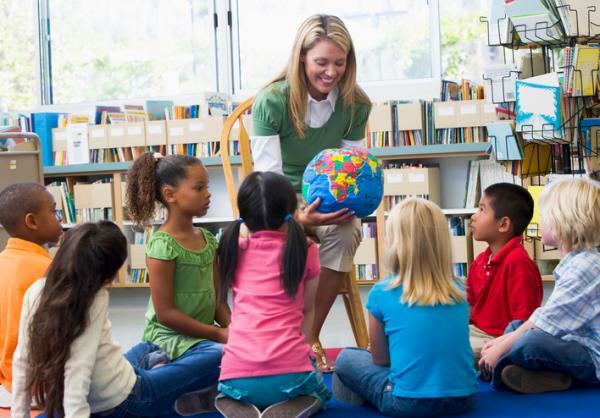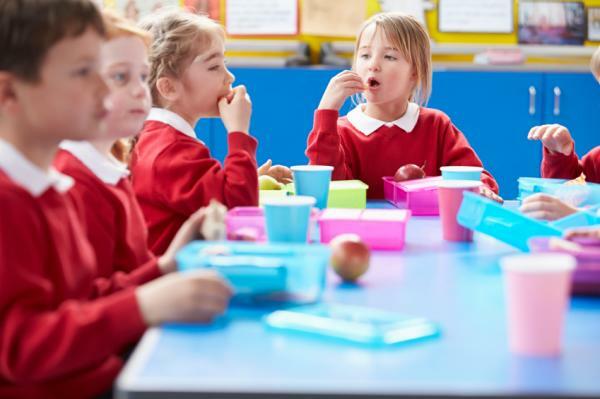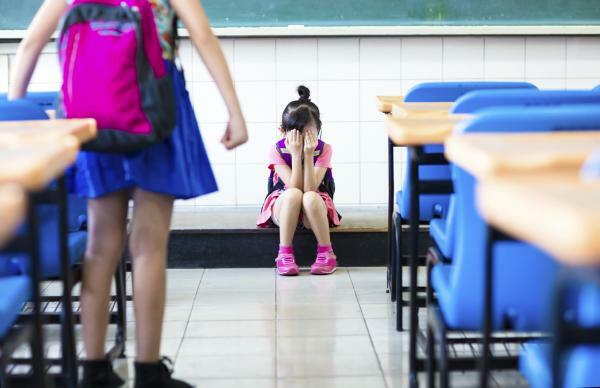
Today a lot is written about communication, the subject is discussed, but it gives the impression that there are many ambiguities and lack of clarification in this regard. When a teenager attends a consultation who does not talk with her parents, it is said that he has communication problems, thus it is concluded if a couple does not feel satisfied; or when referring to a group of students who feel tense and distant, different situations, different environments and the same conclusion.
However, what do we mean when we affirm that in these cases it is a communication problem? How does it originate and does the personality develop? Do significant situations of the diagnosis occur? How does the educational process develop? orientation? In the search for the answers to these questions we will surely find the category communication: a necessity of the school today.
Index
- What is communication
- Types of communication
- Interactions in the classroom
- School group: your organization
- Communication an interactive process.
- Communicative dimension
- Perceptual dimension
- Interactive dimension
- Communication barriers
- Communication in the classroom
- Communication as an indicator of group cohesion
- Communication and spatial distribution of the groups in the class.
What is communication.
Communication, like education as a whole, is a domain of human activity that deepening its study is the privilege of different sciences. The complexity of interpersonal communication requires an interdisciplinary approach. However, at this time we will look at the characteristics of communication from Psychology.
What to understand by communication? What place does communication occupy in human relationships?
“Etymologically the term communication comes from the Latin comunis which means common. By communicating we intend to establish a community with the other, we intend to share information, an idea, an attitude and a feeling.”(Ibarra, L 1988)
The communication is a process of integration between people in which their psychological qualities are expressed and in which their ideas, representations and feelings are formed and developed. Each person has their own communication system based on their attitudes, her orientations regarding whether herself and others, her work, the general organization of her life and a very complex set of factors. Each person's ability to communicate transcends his or her abilities to speak or write adequately. The characteristics of the Personality, its chances of success and self-realization seem to be directly related to its ability to communicate. In this sense, we are referring to interpersonal communication.
By communication we understand a process of interrelation in which all participants do so as subjects. In this process the subject assumes and transmits the message according to his personality and it stimulates the development of cognitive potentialities and of new motives, interests and convictions. It represents the fundamental path of the social determinism of the personality, by this means the historical-cultural experience is synthesized, organized and elaborated. Communicating is recognizing the other, taking him into consideration, in a dynamic, active way. During this process, functions and roles are exchanged, cooperation, understanding and empathy originate. Communication stimulates cognition and affect and can promote reflection.
Types of communication.
In consequence of the above, we identify types of interaction in communication:
- Biological interaction: typical of the newborn with the mother that is not reduced to the satisfaction of biological needs, but rather mediates experiences, emotions and cultural guidelines.
- Personal interaction: refers to the intersubjective link, the encounter with the internal world of the significant "other" throughout its development.
- Cultural interaction: Appropriation of norms, guidelines, codes and values that govern socially as part of a culture.
- Transcendental interaction: It allows the integration of what has been learned with what is acquired progressively.
- Interaction with oneself: This type encourages the development of personality, identity and new relationships with others and with the environment with greater maturity.
Communication and interaction are intertwined to reinforce the relational system that allows the continuous exchange, emission, reception and perception of messages that promotes the improvement of the subject. Communication is analyzed within the frameworks of the personality of the interacting subjects intellectually and affectively involved in this process.
To the fact that personality is revealed in communication, we give it a diagnostic value and it is used in research in the study of the personality and communication categories. How do the social relations in which the subject intervenes affect or not his needs? The communicational process influences the personality in the form of emotions, of meanings for the subjectivation of reality. The interpersonal communication that takes place in the school setting represents a significant factor in the formation and development of the personality of the students. As we get closer to understanding the psychological mechanisms of this process interactional we will be able to carry out the most effective school intervention and better guide teachers, students and fathers and mothers.
Interactions in the classroom.
Due to interactions in the group, members will occupy certain positions and communication guidelines will be established, all of which will influence group behavior. The school group is characterized by temporary stability and this supposes the establishment of the formal (official) structure and the emergence of an informal structure.
The positions that the students occupy Depending on the assigned tasks, it will generate interactions and that skein of relationships is made more complex by the interactions that emerge from the informal structure. The group structure influences:
- The conduct of its members
- Group satisfaction
The norms of behavior of the school groups are also originated by the norms of communication. Likewise, the group's communication process has a significant influence in the informal structure of school groups. All this reveals the close links between interaction, communication and group structure and the need to study the interstices to understand the group behavior of students and design orientation programs for the teacher.
We will not attempt to scrutinize the complexity of the group interaction process but to explore the way in which interaction and communication occurs and the influencing factors.
What to understand by interaction?
Relationships between two or more people in which the actions of one affect the others and vice versa, causing other actions of responses or reactions from each other. These response chains can be different from one subject to the other. To understand the behavior of a child in the face of a specific event in which she interacted with another in school conditions, it would be necessary to consider:
- Personal history (experiences).
- Personological characteristics.
- Development social situation.
- Position in the group.
- Frequency of interactions.
- Intersubjective link.
On a visit to a school we observe the following situation:
In the classroom during break time and shift change Gabriel gives Lester a push. Each belongs to different subgroups of that group. At the beginning of class, Lester takes Gabriel's chair away and he falls causing the laughter of some and the discomfort of others that only ceased due to the intervention of the teacher. In the following days, the rivalry between the subgroups continued, making it difficult for the teacher to prevent outbursts of "revenge" from those who supported one or the other.
The master's concern was that despite the disciplinary measures adopted with the two students (Gabriel and Lester), the group situation generated had split the group of students. In such a way that students who belonged to different subgroups resisted integrating work teams, during recess they did not share games and non-verbal expressions of anger were observed. The teacher told us that in other similar situations "the blood had not reached the river", why on this occasion was the group's behavior violent?
We asked the teacher that since she was comparing two similar situations she would identify the differences. In the previous situation, a student attacked the other, the victim did not react violently, but evaded the confrontation. The group reacted in a different way, not with manifestations of violence. In addition, that student had little interaction in the group.
What does this situation tell us?
The behavior of the group is influenced by the way the members interact as well as the positions they occupy in the group structure. Other influential encounters in the types of interaction are:
- Age
- The gender
- Social acceptance
- Group organization
- Volume
- Communication
Education for human communication can be the best preventive orientation to promote solutions to conflict situations in a constructive way.

School group: your organization.
If we remember the characteristics of the School as an organization, it is not surprising that there are those who recognize class groups as a highly formalized structure (Banny - Johnson, 1971) which means that this organization is predetermined and does not depend on the wishes and preferences of the members of the group.
The school group is formally structured to achieve the objectives set out in the program documents, making it easier for teachers and principals to carry out the tasks assigned to them. their roles rather than to achieve the goals and aspirations of the students, although promoting actions that enable the performance of the role of the teacher encourages the learning of the students. students.
Communication an interactive process.
Considering communication as a form of interaction implies highlighting the active character of the participants in the process. Communication in its interrelation process between two or more people in which all its participants intervene as active SUBJECTS. Conceiving all participants as subjects allows us to transcend the classic communication scheme.
Channel message
ISSUER> RECEIVER
Feedback
SUBJECT> OBJECT
By placing "other" in the position of Receiver, the active character of the subject is overlapped, visualizing it as an entity that receives information or affection and responds to the stimulus in a mechanical, evidencing the quality of the reception of the message (feed - back) which does not imply that the subject (Receiver) is involved in the communicative act, nor compromised their motives and needs.
- The word communication as we expressed previously, it derives from the Latin common which means common. When we communicate, we intend to establish a community with the other, we intend to share information, an idea, an attitude, establish contact, express thoughts and feelings.
- The person initiating the communication is the transmitter who transmits thoughts, opinions, feelings, doubts.
- Receiver It is called who listens, welcomes, receives what is broadcast.
- The content communicated between the two is called message.
- The form used to deliver said message refers to the channel which can be through words, gestures, movements, face to face, in writing.
The elements that make up the communicative process represent a complex, dynamic and interdependent, so that variations in one of them affect the others and one's own communication.
Conceiving communication as an interactive process leads us to rethink the previous scheme to highlight the active character and the condition of subject of all the participants.
SUBJECT SUBJECT
Communication structure:
- Communicative dimension
- Prescribed dimension
- Interactive dimension
Communicative dimension.
It refers to the exchange of information between individuals. Includes items such as:
- Oral, written or gestural source.
- Message or Recipient.
- Primary (verbal) and Secondary (non-verbal) channels.
Communicating means coming into contact with the other, it is penetrating in some way the subjectivity of who (s) we communicate with. Accept that you participate in ours. It means sharing tastes, hobbies, experiences. Assess the content of the messages received, show that we listen attentively and are open to dialogue, not just monologue.
All behavior reveals communicative messages which represent information vehicles that generate links between people. Of the types of verbal and non-verbal communication. They do not always appear coherent, observing discrepancies that could distort the message and damage the relationship or create conflicts.
Verbal communication
The use of verbal means, signs, symbols to convey information provides specific knowledge, which does not promote an interpersonal link. It is the primary level of communication focusing on "what is said" through directly understandable concepts.
Non-verbal communication
The message is expressed through non-verbal forms, which implies an interpretation or translation of the coded language received from the interlocutor. Represents the secondary level of communication focusing on “what is said with gestures or body language. It is characterized by variety and breadth: tone and inflections of the voice, rhythm, cadence, hand contact, face movements, gestures, body postures, silence.
Also the context in which communication takes place is necessary to consider in order to understand what is communicated. The message sent can be understood in different ways and evoke emotions depending on the interlocutor and the context. Sometimes, interference in one and the other cause conflicts, which if this possibility were not considered, the reactive behaviors observed in the others would be inexplicable.

Perceptual dimension.
They stand out the process of mutual insights and understanding between the participants in the communication process. Mutual understanding involves considering the motives, objectives and activities of the other as well as their acceptance as that encourages the realization of joint actions and strengthens the bonds of intimacy and attachment between the participants. It is possible to understand interpersonal attraction in the group if we value the development of the perceptual dimension
Interactive dimension.
It refers to the organization of the interaction between the subjects that can take different forms of:
- Cooperation.
- Competence.
- Agreement.
- Conflict.
- Adaptation.
- Opposition.
- Association.
In this dimension, the emotional element of communication stands out. Evaluating the way in which subjects interact has extraordinary value in educational work. Communication is a form of interaction, it can be considered a indicator of the level of development of the group and its behavior. Dysfunctional communication can create tension or frustration.
In addition, barriers in communication can cause difficulties in setting standards for the functionality of the group and even, be one of the variables that explain the difficulties to learn and the problems of student behavior An accurate diagnosis will allow the teacher to provide the levels of help that develop the potential of the students. students.
When addressing the structure and functions of communication, the informative process in which communication fulfills the function of information exchange; the process of interaction, of reciprocal influence, the communication fulfills in this case a regulatory function of the behavior; and the process of mutual understanding, of interpersonal perception where the emotions of the communicators intervene and which fulfills an affective function. In the process of mutual understanding that is considered essential in the teacher-student relationship, identification mechanisms stand out, mutual perception and empathy that in the conditions of our line of work, the work of the influence of the communication process in the formation of professional motives represents a moment of special attention in the conception of the different work sessions that make up the experiment.
In the teacher-student communication the informative function acquires a great dimension because it is the first that facilitates the construction of systematized knowledge and the necessary experiences in the training of students. Not infrequently this function is hyperbolized to the detriment of the rest, manifesting the asymmetric nature of communication that makes the communication process less effective (Ibarra, L. 1988). Furthermore, because it is a process of interaction, it cannot be conceived in such a way that a pole emits the message and the other only receives that information, but the subject is involved as a personality in the process. In the process of exchanging information there is a mutual influence that affects the behavior of the student. In this sense, it is necessary to take into account that in communication there may be social or psychological barriers raised both by the teacher, If it does not state with crystal clarity its objectives, reasons for communication or if it ignores the needs, interests, motives and attitudes of its students, as well as by the students themselves who may have a distorted perception by the teacher or that the message has not been adequately decoded.
Communication barriers.
We understand communication barriers as interference or obstacles that make it difficult to understand the information, of feelings and behavior. and they impede the functionality of the process and an adequate interpersonal relationship. Some have been identified such as:
- Barrier of self-love: It detracts from the qualities of others and appreciates only their own. It is believed with all the truth and prevents others from speaking.
- Barrier of indifference: The other is heard but is not heard.
- Barrier of superiority: He feels superior to the other, he is not considered as equal in dignity. Consider the other as an object, not as a subject.
- Selective hearing barrier: Hear only what suits you.
- Pattern barrier: When you pigeonhole the other in a certain image.
- Language barrier: When you put irony or mockery before understanding language.
In the communicative process we raise barriers without knowing the consequences for the interaction with the other or how dysfunctional the messages that use terms, evaluative, authoritarian, accusing judgments, that interrogate, trivialize and give solutions or advice sentencing.
In this same sense, overgeneralizations using totalizing, lapidary expressions such as "Always" "never" "nothing" regularly accompanied by an inappropriate emotional charge. As well as the messages or actually the double messages that imply contradictions between verbal and non-verbal communication, the content and affection, speech and behavior or between what is expressed and what is required, "do what I say and not what I do".
To communicate better It would be convenient to observe some aspects:
- Choose a suitable place and time and agreed with the other person
- Reflect on what you want to achieve and how to say it best
- Be aware of how we feel and seek a favorable emotional state to communicate (a good sigh or count to ten Describe the facts, do not qualify, judge or blame. "The music is so loud"
- Express feelings, wishes and opinions in the form of messages "I" ("I am tormented", instead of saying. "You torment me") YOUR messages regularly accuse.
- Recognition of one's own and other's needs. "I know you want to hear music and I need to sleep"
- Negotiate a solution that satisfies the interlocutors "If you listen to the quietest music I can sleep"
- Reflect on possible consequences of their actions
- Use of clear, precise and useful messages
A empathic listening favors the communicative process to the:
- Accept the arguments, objections or criticisms of the other person without this implying that you agree with their behavior or opinions.
- Commit yourself physically and mentally to listen, look at the other, indicate that you are listening by affirming with your head.
- Listen without unnecessary interruptions.
- Leave the pauses to encourage the speaker to what he continues to do.
- Avoid getting defensive.
- Do not distract from the speaker's conversation by disagreeing or talking about yourself.
- Summarize from time to time what the other says to make sure that it has been attended.
In a discussion with a group of mothers and fathers and on another occasion in a meeting with teachers, the reflections were similar, how difficult and how easy it is to communicate properly! and how many barriers we erect without realizing that it distances us from the other in communication. Mastering these elements is an important moment on the path that leads us to establish more developing interpersonal relationships and for this, communication is essential functional.
Communication in the classroom.
If in the classroom the communication is one-way, from the teacher issuing the content to the students and the students are not involved in the communicative process this will be deficient, because there are no opportunities for dialogue or exchange, the interactive space is not created and there is no participation for various reasons: for fear of being wrong, for lack of motivation, because the right moment was not generated, etc. Teachers could reduce discipline problems in the classroom, if they promoted effective communication in which students had the possibility to interact, exchange opinions and criteria freely and communication was also a student - student not only in a vertical direction teacher - student.
Limiting exchange and dialogue between students during class does not eliminate the need to express feelings or ideas of satisfaction or discomfort, only it contains or inhibits them. These will manifest themselves at another time, in the recess or in another class, but as an outburst due to the pressure to which the student has been subjected. group. This aspect is also observed in the learning process, in which not infrequently, the lack of ability to generate a participatory discussion provokes mechanical questions and answers that do not guarantee high-quality production or construction of the knowledge.
Observing how things are said clarifies their meaning and contributes to the teacher's work in educating the group. Education models associated with communication models have been identified according to the classification of J. Díaz Bordenave (Ojalvo, 1995):
Education with an emphasis on content
The teacher assumes the leading role in the process of transmitting information and values from the place of power and knowledge. The student is placed in the place of Ignorance, of not knowing, passively receives and receives what is transmitted, the depository of knowledge, the implication of the subject in the learning situation is not encouraged. This model is typical of traditional teaching. It is associated with the previous educational conception, the classic model of communication, characterized by a subject - object relationship, vertical, authoritarian and monological from one direction: that of the teacher.
Education with an emphasis on effects
Education with an emphasis on effects represents an attempt to activate teaching with the introduction of technical media such as television, video, radio, among others. Educational Technology fundamentally addresses the formation of habits in students based on programmed stimuli and planned by the teacher, to which the student will respond and repeat the exercise until the expected effect and its automation. Student participation is mechanical and passive and subordinate to repetitive actions designed by the teacher who remains as in the previous model, owner of knowledge and controlling the results. Communication continues to be unidirectional, vertical, the teacher sends messages and schedules feedback in the form of encouragement and punishment, for the formation of habits. A real participation of the subject based on his needs and motives is not encouraged. This does not mean that the introduction of technical means in teaching entails this model. Its use can also promote the involvement of the student as a subject of learning, depends on the objectives and conception of education.
Education with an emphasis on process
Education focused on the process, the teacher stimulates the construction of knowledge in the student and encourages and learning, assuming a leading role and participating as a subject. Communication in this model is an interactive process, the relationship is subject-subject, it is stimulated the ebb and flow of information, the exchange between teacher and students and between the students themselves students. A true communicative dialogue takes place, an influential factor in the formation of the personality, because by committing oneself as a person, consider their needs and motives in learning, actively participate in the formation of their values and their preparation for the lifetime. The first two models are still intermingled in our classrooms, although the teacher is in a process of learning how to move around the place knowledge, traditionally recognized and accepting that others, students also have knowledge, which will awaken interest in what they they learn. A dialogic communication is a way to undertake this other way to play our role and become better educators.

Communication as an indicator of group cohesion.
Faced with a group with a high level of group cohesion, it can be predicted that there will be high communication among its members. To the extent that a group presents a high level of cohesion, we will find fewer individual differences in terms of the amount of interaction. Student satisfaction and liking for the group is increased by interaction.
If he student does not perceive that he is accepted For the other members of the school group, their emotional responses tend to restrict their participation in group affairs. The teacher can better manage the group to the extent that he takes into account issues such as: students who occupy a lower position want to achieve acceptance group and find as a substitute way of satisfying that desire to resort to increasing communication with the students who occupy central positions in the group.
The school group dimensions influences communication. Faced with a large group, the possibilities of interaction and communication decrease as well as the participation of the students in the class.
Also the school dimension limits communication between students. This factor must be considered in teaching activities such as seminars, workshops and others in which the possibilities for students to intervene in the debate are minors and like the interaction between them, especially since in these tasks the time is framed in class shifts with a limited time and in a large group The student would have to wait for his turn to come and her intervention may not coincide with the course of the discussion because that issue has already been left behind.
On the other hand, some experience a sense of threat when exposing themselves to the group, inhibiting participation by having the impression that their opinions are not important and do not deserve to be contributed. Observing an inversely proportional relationship between group size and group participation and self-satisfaction. The explanation of the above is shown by studying the group factors, which in turn affect the communicative process:
large groups have a greater number of members and we find more individual differences between them. a large school group is maintained for a period and creates an informal structure in accordance with the formally established one. The network of relationships is made more complex by the structure and mutual perceptions and affects communication.
A large group tends to split into subgroups, which are what make interaction between members possible. Regarding the leadership of the school group by the teacher, it is observed that in large groups the direction tends to be more centered on the teacher, less participatory and that represents a challenge for the teacher the formation of group management skills so that they do not use leadership practices authoritarian. In addition, it is necessary to recognize the work possibilities offered by small groups in the that the ability to influence students increases in contrast to what is expressed about groups large.
Communication and spatial distribution of the groups in the class.
Contributions from group studies, teacher experience, and school-based research point to consider that the attitude of students to interact is favored if they can hear and see each other, which allows them to capture not only the verbal messages but also achieve non-verbal communication, where to locate the most participatory students who sometimes monopolize the discussions? And the ones that are quieter? How to promote communication between students and not only in the sense of the teacher and the student?
It has been proven that spatial arrangement in the shape of a circle It turns out to be satisfactory by promoting interaction at the horizontal level. However, it is necessary to take into account the task and the size of the group when deciding the most favorable variant. In a large school group, the spatial distribution in a circle may not be the most suitable for effective communication because the distance between the members does not stimulate integration between these. It cannot always be avoided that communication is directed towards the teacher. To this must be added that those students who are shy or who find it difficult to express their ideas feel more exposed to others in compared to other provisions that would place them in an anonymous type position that offers them more security to expose their ideas.
In the groups of small schoolchildren Faced with the alternative of freely choosing where to locate themselves, it has been observed that these students place themselves around the teacher, an authority figure and that he offers them security. Another element to consider is that shy students frequently occupy the front row with the intention of intervening without the peer pressure that they will experience in other positions in the classroom. These factors influence the nature, quality and quantity of interpersonal relationships contribute to the development of oral expression, one of the most important skills in schooling.
In some pedagogical practices and in the literature, the spatial distribution of boys and girls is devalued in rows or columns. In this regard, it should be noted that there seems to be a relationship between the way of interacting and the type of task, or activity in class. If the objective of the class involves the performance of individual tasks, the placement in rows and columns that limit communication and interaction favors the individual executor. While, in the classes cooperative learning is stimulated, which promotes exchange among students to achieve the Class objective would facilitate this purpose a spatial arrangement that encourages communication and student-student interaction. In summary, the knowledge of these links between communication and spatial arrangement in the classroom facilitates that the teacher's work is more effective and improves the leadership and management of the group school. During class regularly, students are not given an opportunity to express themselves and teachers tend to focus on the content, what they want to communicate, the message is understood and the response of the students. When the teacher conceives education and communication as a process of interaction, he will also attend to what the students want express, stimulate and promote the conditions in the classroom, design the class that allows the relationship teacher - student, students - students.
The conception about the discipline in class and the philosophy of the school around the meaning of the communication between the disciples will influence in the teacher's behavior, in the attitude he assumes in the face of classroom conversations and his concern or not because only his his voice. In school groups that are given few opportunities to communicate during periods organized very long, they satisfy your communication needs in spaces such as recess or in the own classes. When students feel that they have free time or no activities and can interact, they do so chaotic way, as an escape from the pressure they have experienced by not being able to communicate during lessons. A silent class in which only the voice of the teacher is heard may seem to some a paradigm of a “disciplined” class for others, the conditions are not conducive to developmental learning nor does it create a group climate that benefits relationships and communication. From all the above, it cannot be concluded that control is not necessary, the order this would lead to the manifestation of disruptive behaviors and would obstruct the learning process. Communication and education are two indissoluble processes. If we consider their links and the most functional ways of proceeding, we will bet on a greater impact on the psychological development of our children.
This article is merely informative, in Psychology-Online we do not have the power to make a diagnosis or recommend a treatment. We invite you to go to a psychologist to treat your particular case.
If you want to read more articles similar to Communication: a necessity of today's school, we recommend that you enter our category of Socialization problems.
Bibliography
- Banny, M and Jonson, L (1971) Group dynamics in education. Edit. People and Education, Havana.
- Ibarra, L. (1988) The formation of professional intentions in university students. Doctoral thesis.
- Ibarra, L. (2003) Educating at school, educating in the family, reality or utopia? University of Guayaquil, Ecuador.
- Korniev, N (1985). Human communication. In: Socio-psychological aspects of communication. Faculty of Psychology. University of Havana.
- Lomov, B (1985). Communication and social regulation of the individual's behavior. In: Sociopsychological aspects of communication. Faculty of Psychology. University of Havana.
- Ojalvo, V (1995) Education as a process of interaction and communication Pedagogy 95 Presentation La Habana.


